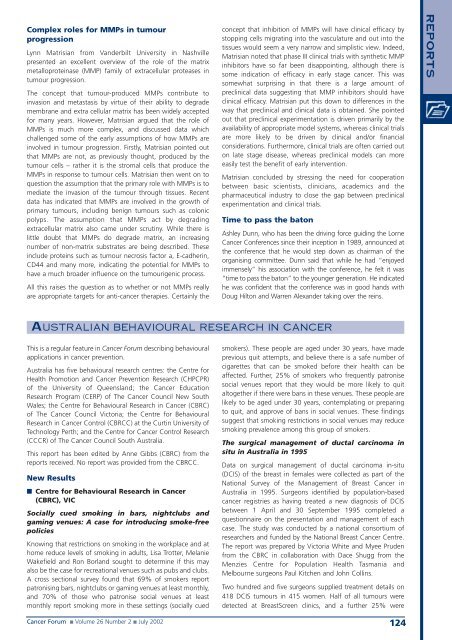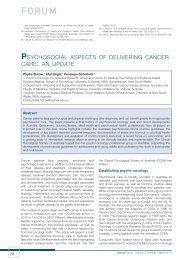Cancer Forum
Cancer Forum
Cancer Forum
- No tags were found...
You also want an ePaper? Increase the reach of your titles
YUMPU automatically turns print PDFs into web optimized ePapers that Google loves.
Complex roles for MMPs in tumourprogressionLynn Matrisian from Vanderbilt University in Nashvillepresented an excellent overview of the role of the matrixmetalloproteinase (MMP) family of extracellular proteases intumour progression.The concept that tumour-produced MMPs contribute toinvasion and metastasis by virtue of their ability to degrademembrane and extra cellular matrix has been widely acceptedfor many years. However, Matrisian argued that the role ofMMPs is much more complex, and discussed data whichchallenged some of the early assumptions of how MMPs areinvolved in tumour progression. Firstly, Matrisian pointed outthat MMPs are not, as previously thought, produced by thetumour cells – rather it is the stromal cells that produce theMMPs in response to tumour cells. Matrisian then went on toquestion the assumption that the primary role with MMPs is tomediate the invasion of the tumour through tissues. Recentdata has indicated that MMPs are involved in the growth ofprimary tumours, including benign tumours such as colonicpolyps. The assumption that MMPs act by degradingextracellular matrix also came under scrutiny. While there islittle doubt that MMPs do degrade matrix, an increasingnumber of non-matrix substrates are being described. Theseinclude proteins such as tumour necrosis factor a, E-cadherin,CD44 and many more, indicating the potential for MMPs tohave a much broader influence on the tumourigenic process.All this raises the question as to whether or not MMPs reallyare appropriate targets for anti-cancer therapies. Certainly theconcept that inhibition of MMPs will have clinical efficacy bystopping cells migrating into the vasculature and out into thetissues would seem a very narrow and simplistic view. Indeed,Matrisian noted that phase III clinical trials with synthetic MMPinhibitors have so far been disappointing, although there issome indication of efficacy in early stage cancer. This wassomewhat surprising in that there is a large amount ofpreclinical data suggesting that MMP inhibitors should haveclinical efficacy. Matrisian put this down to differences in theway that preclinical and clinical data is obtained. She pointedout that preclinical experimentation is driven primarily by theavailability of appropriate model systems, whereas clinical trialsare more likely to be driven by clinical and/or financialconsiderations. Furthermore, clinical trials are often carried outon late stage disease, whereas preclinical models can moreeasily test the benefit of early intervention.Matrisian concluded by stressing the need for cooperationbetween basic scientists, clinicians, academics and thepharmaceutical industry to close the gap between preclinicalexperimentation and clinical trials.Time to pass the batonAshley Dunn, who has been the driving force guiding the Lorne<strong>Cancer</strong> Conferences since their inception in 1989, announced atthe conference that he would step down as chairman of theorganising committee. Dunn said that while he had “enjoyedimmensely” his association with the conference, he felt it was“time to pass the baton” to the younger generation. He indicatedhe was confident that the conference was in good hands withDoug Hilton and Warren Alexander taking over the reins.ReportsAustralian Behavioural Research in <strong>Cancer</strong>This is a regular feature in <strong>Cancer</strong> <strong>Forum</strong> describing behaviouralapplications in cancer prevention.Australia has five behavioural research centres: the Centre forHealth Promotion and <strong>Cancer</strong> Prevention Research (CHPCPR)of the University of Queensland; the <strong>Cancer</strong> EducationResearch Program (CERP) of The <strong>Cancer</strong> Council New SouthWales; the Centre for Behavioural Research in <strong>Cancer</strong> (CBRC)of The <strong>Cancer</strong> Council Victoria; the Centre for BehaviouralResearch in <strong>Cancer</strong> Control (CBRCC) at the Curtin University ofTechnology Perth; and the Centre for <strong>Cancer</strong> Control Research(CCCR) of The <strong>Cancer</strong> Council South Australia.This report has been edited by Anne Gibbs (CBRC) from thereports received. No report was provided from the CBRCC.New Results■ Centre for Behavioural Research in <strong>Cancer</strong>(CBRC), VICSocially cued smoking in bars, nightclubs andgaming venues: A case for introducing smoke-freepoliciesKnowing that restrictions on smoking in the workplace and athome reduce levels of smoking in adults, Lisa Trotter, MelanieWakefield and Ron Borland sought to determine if this mayalso be the case for recreational venues such as pubs and clubs.A cross sectional survey found that 69% of smokers reportpatronising bars, nightclubs or gaming venues at least monthly,and 70% of those who patronise social venues at leastmonthly report smoking more in these settings (socially cuedsmokers). These people are aged under 30 years, have madeprevious quit attempts, and believe there is a safe number ofcigarettes that can be smoked before their health can beaffected. Further, 25% of smokers who frequently patronisesocial venues report that they would be more likely to quitaltogether if there were bans in these venues. These people arelikely to be aged under 30 years, contemplating or preparingto quit, and approve of bans in social venues. These findingssuggest that smoking restrictions in social venues may reducesmoking prevalence among this group of smokers.The surgical management of ductal carcinoma insitu in Australia in 1995Data on surgical management of ductal carcinoma in-situ(DCIS) of the breast in females were collected as part of theNational Survey of the Management of Breast <strong>Cancer</strong> inAustralia in 1995. Surgeons identified by population-basedcancer registries as having treated a new diagnosis of DCISbetween 1 April and 30 September 1995 completed aquestionnaire on the presentation and management of eachcase. The study was conducted by a national consortium ofresearchers and funded by the National Breast <strong>Cancer</strong> Centre.The report was prepared by Victoria White and Myee Prudenfrom the CBRC in collaboration with Dace Shugg from theMenzies Centre for Population Health Tasmania andMelbourne surgeons Paul Kitchen and John Collins.Two hundred and five surgeons supplied treatment details on418 DCIS tumours in 415 women. Half of all tumours weredetected at BreastScreen clinics, and a further 25% were<strong>Cancer</strong> <strong>Forum</strong> ■ Volume 26 Number 2 ■ July 2002 124









